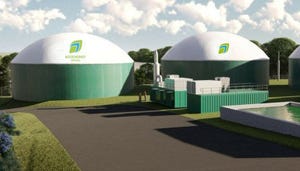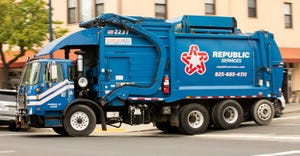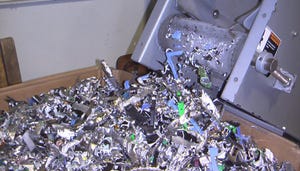Managing Waste With Collection
November 1, 1993
William Knapp
One of the hot refuse collection topics is variable rates, or charging by weight or volume. The theory behind variable rates is that everyone should pay for the waste he or she produces; the difficulty revolves around which basis to use for measuring and whether the benefits justify the cost.
Many municipalities include costs of solid waste handling in taxes. Some charge a flat fee based on the average cost of service per household per year. Most private haulers charge a fee per barrel, or a fee based on the needed container's volume.
Volume based charges have existed for a while now. The key is that most municipalities do not vary fees on a house-by-house basis since it is costly and cumbersome. The inequity of some residents getting more service for the same price as their neighbors hasn't been a big enough factor to prompt change. So why the fuss now?
One factor has been the sensitizing of the public to disposal problems. Another has been the success of recycling advocates selling recycling as a disposal option.
Recycling was a backwater concern until the field of solid waste disposal announced a crisis looming in disposal space. As sites filled, and were labeled as environmentally unsound, new landfills were harder to site. Burn technology was rejected as an alternative by the new environmentally-concerned public.
Recycling advocates sold their ideas to concerned citizens and apprehensive politicians. The recycling credo was that valuable resources were being thrown away as waste when they could be returning money and making landfills less needed. Recycling activists blocked the implementation of disposal plans not including recycling elements, which led to changes in collection, handling and disposal of the waste stream. Equipment was needed to handle waste in new ways; information was needed to track benefit costs of this expensive way of classifying the waste stream; geophysical imaging systems, bar coding, computer read transponders, electronic scales and new technology could be used for the new "Trash Wars" problems.
When curbside recycling above the 10 percent participation level proved difficult, and costs of recycling proved to be higher than anticipated, thoughts turned to how the public could be urged to recycle more. Money became a motivator since the appeal to "do the right thing" had not been encouragement enough.
Variable rates approached success differently. Weighing devices, transponders, computerized readers, billing and compilation software and semi-automated and automated collection systems made weight-based concepts seem feasible. Bar-coding and readable encoded transponders on containers allowed operators to identify and gather information by a reading mechanism. The reading mechanism was then coupled with a scale mechanism on the arm or vehicle that collected the container.
The container, its owner and the date could be identified and the container's weight could be determined by computer. The computer could prepare the bill, address the envelope and even record it paid.
Unfortunately, this method has a hitch. The technology, especially the scale, has not been accurate enough to pass governmental requirements for weight-based billing. Another deterrent is the high cost of the components, containers, automation, computers, software and increased administrative and technical personnel.
Yet there is an alternative: volume-based billing. After all, doesn't landfill space represent volume? Isn't that what is filling and increasing in price as it decreases in quantity? It seems fair that people pay for quantity, not weight. The method often used is to issue varying sizes of containers. Residents are billed at rates according to varying volume. It is hoped that economics will act as an incentive for people to request smaller containers as they learn to recycle.
Some of the technology can be bypassed. The extensive inventory and replacement mechanism required for this concept is a bit costly, too. Multiple-size containers must be bought, stored, delivered and exchanged. Volume will also vary with the seasons. Varying rates headaches begin to match weight-based system headaches.
The variable rate option attempts to make everyone pay for their share of disposal and collection carts. The efficient accounting and billing encourages more recycling. But do these attempts work? We are at this point because a disposal problem, disappearing landfill space, put the spotlight on solid waste management. Collection was not the problem; it has become part of the solution.
There are all kinds of measuring and billing techniques, but they all cost. As always, it depends on what your goals are and how much reaching them is worth to you. After all, there is no free lunch.
Next month, I'll take a look at disposal alternatives and examine the recycling issue as well as considering more of the variable rates option and why it is such a hot topic in the refuse collection industry.
Disposal alternatives have remained the same: landfilling, burn refuse derived fuel, recycling and reduction. Reduction is the most promising disposal alternative and variable rate systems encourage waste reduction. You produce less; you pay less.
Recycling doesn't reduce waste production; it shifts part of the waste stream away from the other disposal methods. Reduction and disposal methods reduce the amount of personnel, equipment and financial resources required for collection; recycling increases them. Most cities pass this cost on to the customer through monthly rates or yearly taxes.
Recycling has great benefits, but it is not a cheap disposal alternative. Recycling does teach people to think consciously about solid waste: what it is, how it is created and what we do with it. It begins to re-align our thinking toward living with the environment and not in spite of the environment. I feel that we should recycle because it is the right thing to do, not because we falsely believe it is a money maker. After deducting the money received for the recyclables, and the money not paid to landfill it, the equipment, labor and administrative costs of collecting a ton of recyclables is more for most communities.
Are variable rates a good idea? My answer is - it depends. If the intent is to control how much waste is produced, encourage recycling, make the public aware of the costs of waste processing and encourage waste reduction, then the answer is yes as long as you don't have to worry about the cost of the process. If cost of waste processing is a paramount concern, then variable rates may not be the best option.
You May Also Like


